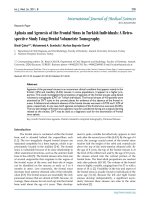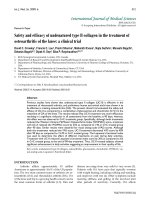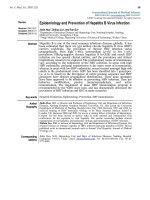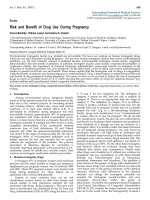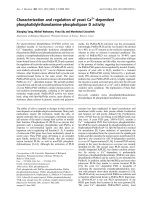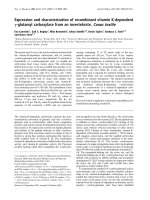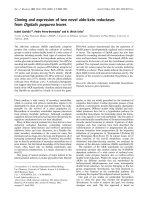Báo cáo y học: " Safety and efficacy of undenatured type II collagen in the treatment of osteoarthritis of the knee: a clinical trial"
Bạn đang xem bản rút gọn của tài liệu. Xem và tải ngay bản đầy đủ của tài liệu tại đây (265.83 KB, 10 trang )
Int. J. Med. Sci. 2009, 6
312
I
I
n
n
t
t
e
e
r
r
n
n
a
a
t
t
i
i
o
o
n
n
a
a
l
l
J
J
o
o
u
u
r
r
n
n
a
a
l
l
o
o
f
f
M
M
e
e
d
d
i
i
c
c
a
a
l
l
S
S
c
c
i
i
e
e
n
n
c
c
e
e
s
s
2009; 6(6):312-321
© Ivyspring International Publisher. All rights reserved
Research Paper
Safety and efficacy of undenatured type II collagen in the treatment of
osteoarthritis of the knee: a clinical trial
David C. Crowley
1
, Francis C. Lau
2
, Prachi Sharma
1
, Malkanthi Evans
1
, Najla Guthrie
1
, Manashi Bagchi
2
,
Debasis Bagchi
2,3
, Dipak K. Dey
4
, Siba P. Raychaudhuri
5,6,
1. KGK Synergize Incorporated, London, ON, Canada
2. Department of Research and Development, InterHealth Research Center, Benicia, CA, USA
3. Department of Pharmacology and Pharmaceutical Sciences, University of Houston College of Pharmacy, Houston, TX,
USA
4. Department of Statistics, University of Connecticut, Storrs, CT, USA
5. Department of Medicine, Division of Rheumatology, Allergy and Immunology, School of Medicine, University of
California Davis, Davis, CA, USA
6. VA Medical Center Sacramento, Hospital Way, Mather, CA, USA
Correspondence to: Siba P. Raychaudhuri,
Received: 2009.07.14; Accepted: 2009.10.08; Published: 2009.10.09
Abstract
Previous studies have shown that undenatured type II collagen (UC-II) is effective in the
treatment of rheumatoid arthritis, and preliminary human and animal trials have shown it to
be effective in treating osteoarthritis (OA). The present clinical trial evaluated the safety and
efficacy of UC-II as compared to a combination of glucosamine and chondroitin (G+C) in the
treatment of OA of the knee. The results indicate that UC-II treatment was more efficacious
resulting in a significant reduction in all assessments from the baseline at 90 days; whereas,
this effect was not observed in G+C treatment group. Specifically, although both treatments
reduced the Western Ontario McMaster Osteoarthritis Index (WOMAC) score, treatment
with UC-II reduced the WOMAC score by 33% as compared to 14% in G+C treated group
after 90 days. Similar results were obtained for visual analog scale (VAS) scores. Although
both the treatments reduced the VAS score, UC-II treatment decreased VAS score by 40%
after 90 days as compared to 15.4% in G+C treated group. The Lequesne’s functional index
was used to determine the effect of different treatments on pain during daily activities.
Treatment with UC-II reduced Lequesne’s functional index score by 20% as compared to 6%
in G+C treated group at the end of 90-day treatment. Thus, UC-II treated subjects showed
significant enhancement in daily activities suggesting an improvement in their quality of life.
Key words: undenatured type II collagen, osteoarthritis, glucosamine, chondroitin, WOMAC, vis-
ual analog scale, Lequesne’s Functional Index
INTRODUCTION
Arthritis afflicts approximately 43 million
Americans or approximately 16.6% of the US popula-
tion. The two most common types of arthritis are os-
teoarthritis (OA) and rheumatoid arthritis (RA). OA
of the knee and hip is a growing health concern and is
the most common forms of arthritis (1-3). Pain and
disease can range from very mild to very severe (3).
Patients with OA have pain that typically worsens
with weight bearing, including walking and standing,
and improves with rest (4). Other symptoms include
morning stiffness and gelling of the involved joint
after periods of inactivity. Currently, OA affects
Int. J. Med. Sci. 2009, 6
313
nearly 21 million people in the United States, ac-
counting for 25% of visits to primary care physicians,
and half of all Non-Steroidal Anti-Inflammatory
Drugs (NSAID) prescriptions. The diverse clinical
patterns of OA are observed in approximately 10% of
people older than 60 years thus compromising the
quality of life of millions of Americans. In addition,
OA costs the North American economy approxi-
mately $60 billion per year.
Current treatment of OA includes exercise,
heat/cold therapy, joint protection, weight loss,
physiotherapy/occupational therapy and medica-
tions (3-5). The most common medications include
acetaminophen and NSAIDs. Although these drugs
are effective for reducing pain associated with OA,
they do not reverse the disease. In addition, there are
considerable side effects associated with the use of
these drugs. As a result, OA sufferers have turned to
natural nutraceuticals to ease their pain and discom-
fort. These products are commonly used because they
are well tolerated and considered safe. Nutraceuticals
are defined as functional foods, natural products, or
parts of food that provide medicinal, therapeutic, or
health benefits, including the prevention or treatment
of disease. Currently, glucosamine and chondroitin
are the two most commonly used nutraceuticals in
humans as well as in animals to alleviate pain associ-
ated with arthritis (6). However, recent randomized
controlled trials and meta-analysis of these supple-
ments have shown only small-to-moderate sympto-
matic efficacy in human OA (7). An emerging novel
nutraceutical ingredient known as UC-II has received
considerable attention in the treatment of OA. UC-II is
a novel undenatured type II collagen derived from
chicken sternum cartilage. Previous studies have
shown that undenatured type II collagen is effective
in the treatment of RA (8-11), and preliminary human
(12) and animal (13) trials have shown it to be effective
in treating OA. Obese-arthritic dogs given 4 mg or 40
mg daily dose of UC-II for 90 days showed significant
declines in overall pain, pain during limb manipula-
tion and lameness after physical exertion (14). Greater
improvement was observed with the 40 mg dose. No
adverse effects or significant changes in serum chem-
istry were noted. Following UC-II
withdrawal for a period of 30 days,
all dogs experienced a relapse of overall pain, exer-
cise-associated lameness and pain upon limb ma-
nipulation. Studies have also shown that small doses
of orally administered undenatured type II chicken
collagen inhibit killer T-cell attack (15). The present
clinical trial evaluated the safety and efficacy of UC-II
in the treatment of the knee in OA patients.
Materials and Methods
Study Design
This clinical trial (Human Clinical Trial Ap-
proval #06UOHI) was managed by KGK Synergize
Inc. (London, ON, Canada). The study was conducted
at two sites: 1) KGK Synergize Inc., and 2) Corunna
Medical Research (Corunna, ON, Canada). Figure 1
illustrates the study design while Table 1 lists the
procedures and observations at each time point.
Briefly, at screening (Visit 1) the consent form
was discussed, signed and a complete physical ex-
amination was performed. Activity level, diet history,
medication/supplement use and medical history
were recorded. The VAS score, the WOMAC Index
and Lequesne scores were obtained. Urine was col-
lected for a pregnancy test for women of childbearing
potential. A blood sample was taken for determina-
tion of uric acid, CBC count and differentiation, al-
bumin, total protein, sodium, potassium, chloride,
BUN, creatinine, ALT, AST, bilirubin, erythrocyte
sedimentation rate (ESR) and rheumatoid factor.
Upon review of blood test results, eligible subjects
were instructed to get an X-ray of the affected knees to
confirm diagnosis. A total of 52 subjects were re-
cruited using the inclusion and exclusion criteria out-
lined in Table 2. At the first treatment visit (Visit 2),
selected subjects were randomly assigned to receive
UC-II (n = 26) or glucosamine HCl plus chondroitin
sulfate (n = 26, G+C). On each test day (day 0, 30, 60,
90), subjects were required to come to the clinic for
clinical assessment. The clinical assessments included
WOMAC, Lequesne’s functional index and 100-mm
VAS pain scores. A subject treatment diary was com-
pleted by each patient throughout the study period to
determine side effects, medication use, and product
compliance.
Figure 1. UC-II clinical study design.
The study was a two-site, randomized,
double-blind study conducted in Lon-
don, Ontario and Corunna, Ontario,
Canada.
Visit 1
Physical
assessment,
medical
history, clinical
assessments
an
d blood
tests
as indicated
Screening
0
30
60
90
Treatment Perio
d (Days )
Visit 4
Clinical
assessments as
indicated
Visit 3
Clinical
assessments as
indicate
d
Visit 2
Randomization
Clinical
assessments as
indicate
d; first
dose in clinic
Visit 5
Clinical
assessments
as indicate
d
Int. J. Med. Sci. 2009, 6
314
Table 1. Schedule of observations and procedures
Procedure Visit 1
Screening
Visit 2
Day 0
Visit 3
Day 30
Visit 4
Day 60
Visit 5
Day 90
Informed consent X
Review inclusion/exclusion X X X X X
Medical history including activity level and diet history X
Physical examination X
Biometric measurements:
Weight, height*, heart rate and blood pressure.
X X X X X
Urine pregnancy test X
Concomitant medications X X X X X
Blood samples:
Uric acid, CBC count and differentiation, albumin, total
protein, sodium, potassium, chloride, BUN, creatinine,
ALT, AST, bilirubin, ESR, rheumatoid factor
X X
WOMAC, VAS and Lequesne scores X X X X X
X-ray X
Randomization X
Blood sample: ALT, AST, bilirubin, albumin.
X
†
X
†
Knee flexion, Time to walk 50m, Swelling in the knee joint,
Time for climbing 10 steps
X X X X
Physician's Global Assessment X X X X
Subject's Global Assessment X X X X
Investigational Product dispensed X X X
Subject Treatment Diary dispensed X X X
Investigational Product returned
Compliance calculated
X X X
Subject Treatment Diary returned X X X
Adverse Events X X X
* height was only measured at visit 1
†
If acetaminophen use was greater than 2 g/day for more than 7 days
Table 2. Inclusion and exclusion criteria
Inclusion Criteria
Males and females 40-75 years old
Females of childbearing potential must agree to use a medically approved form of birth control and have a negative urine pregnancy test
result
Unilateral or bilateral OA of the knee for greater than 3 months (American College of Rheumatology criteria) confirmed by radiologist's
report, i.e. X-rays showing osteophytes, joint space narrowing or subchondral bone sclerosis (eburnation)
Erythrocyte sedimentation rate (ESR) < 40 mm/hr
Moderate OA as indicated by Lequesne’s functional index score of 4.5-7.5 after 7 day withdrawal of usual medications
Able to walk
Availability for duration of study period (3-4 months)
Subject using other therapies for OA, such as exercise, heat/cold therapy, joint protection and physiotherapy/occupational therapy agrees
to continue these therapies as normal avoiding changes in frequency or intensity and to record therapies in the study diary
Subject agrees not to start any new therapies for OA during the course of the study
Able to give informed consent
Exclusion Criteria
History of underlying inflammatory arthropathy; septic arthritis; inflammatory joint disease; gout; pseudogout; Paget's disease; joint frac-
ture; acromegaly; fibromyalgia; Wilson's disease; ochronosis; haemochromatosis; heritable arthritic disorder or collagen gene mutations or
rheumatoid arthritis
History of asthma, history of diabetes (Type I or Type II)
Hyperuricemia (urate, males > 480 umol/L, females > 450 umol/L)
Expectation of surgery in the next 4 months
Recent injury in the area affected by OA of the knee, i.e. meniscal tear (past 4 months)
Cartilage reconstruction procedure in the target knee
Severe OA as indicated by Lequesne’s functional index score of 8 or greater, after 7 day withdrawal of usual medications
Intra-articular corticosteroid injections in the target knee within the last 3 months
Viscous injections in the target knee within the last 6 months
Hypersensitivity to NSAIDs
Abnormal liver or kidney function tests (ALT or AST > 2 times the upper limit of normal; elevated creatinine, males > 125 umol/L, females >
110 umol/L)
Int. J. Med. Sci. 2009, 6
315
Abnormal findings on complete blood count
History of coagulopathies, history of peptic ulceration and upper GI hemorrhage
Uncontrolled hypertension
History of congestive heart failure, history of allergic reaction to chicken and/or eggs
History of allergic reaction to local anesthetic or to any ingredients in the test product including shellfish
Hyperkalemia (potassium > 6.2 mmol/L)
Anticipated problems with product consumption
History of cancer as well as gastrointestinal, renal, hepatic, cardiovascular, hematological, or neurological disorders
High alcohol intake (>2 standard drinks per day)
Pregnant, breastfeeding or planning to become pregnant during the study
History of psychiatric disorder that may impair the ability of subjects to provide written informed consent
Use of other natural health products, including glucosamine and chondroitin, one month prior to study and during the study, other than
multivitamin and mineral supplements containing vitamins and minerals as the sole medicinal ingredients
Use of concomitant prohibited medication (narcotics, oral NSAIDs, topical NSAIDs) within four weeks of randomization
Use of acetaminophen or ibuprofen within 7 days of randomization
Subject is unwilling to stop taking pain medication other than the study medication (for arthritis or other types of pain) or is unwilling to
stop taking other medications for the treatment of OA
Any other condition that, in the opinion of the investigator, would adversely affect the subject's ability to complete the study or its measures
Supplements
Each UC-II (InterHealth Nutraceuticals, Inc.,
Benicia, CA) capsule contained 20 mg UC-II stan-
dardized to 5 mg of bioactive undenatured type II
collagen. Subjects in the UC-II group were instructed
to take two “sugar pills” in the morning to protect
blinding and two UC-II capsules in the evening ac-
counting for a daily dose of 40 mg UC-II containing 10
mg of bioactive undenatured type II collagen.
Each G+C capsule contains 375 mg of
glucosamine HCl (USP Grade) and 300 mg of chon-
droitin sulfate (USP Grade). The subjects were in-
structed to take two G+C capsules in the morning and
two in the evening for a daily dose of 1500 mg gluco-
samine and 1200 mg chondroitin.
Removal of Patients from Therapy or Assess-
ment
The criteria for removal of patients from the
study included:
Adverse events
For any adverse event, patients were examined
and appropriately managed or the patients would be
referred to another medical professional for proper
evaluation and treatment. If medical problems were
attributed to the trial compounds, then the trial drugs
were discontinued and the toxicities were reported.
Personal reasons
As stated in the Consent Form, subjects were
able to withdraw from the study for any reason at any
time.
Clinical judgment of physician
Subjects were withdrawn from the study
(without penalty) if, in the opinion of the treating
physician, it was not in the patient’s best interest to
continue. For instance, if during the course of the
study a patient became pregnant, she would be with-
drawn from the study because it was not known how
the study compounds/medications might affect an
unborn child.
Protocol violation
Any subject found to have entered this study in
violation of the protocol or failed to follow the study
protocol were discontinued from the study at the
discretion of the Principal Investigator. Subjects were
withdrawn for protocol non-compliance if they ad-
hered to the dosing schedule less than 75% of the
time.
Method of assigning patients to treatment groups
Patients were assigned to treatment groups (or-
der of treatments) using computer-generated ran-
domization tables. Patients were not stratified or as-
signed using any other specific method and were not
randomized after stratification or blocking proce-
dures.
Selection of doses in the study
The justification for the daily dose of 40 mg
UC-II in capsules (providing 10 mg of undenatured
collagen II) is based on efficacy demonstrated in ear-
lier studies (8,9).
Blinding
In order to protect blinding, subjects were
given bottles containing product labeled with “AM”
or “PM” to distinguish the time in which treatment
was to be taken. Each bottle contained descriptions of
all potential products to ensure blinding was pro-
tected. Additionally, each bottle was labeled with a
randomization number. In the event that an adverse
effect was considered serious and related to the in-
vestigational product, the blind would be broken for
Int. J. Med. Sci. 2009, 6
316
that individual subject.
Neither the patient, nor investigator, nor re-
search staff, were aware which test compound the
subject was assigned. Interim analysis was performed
in order to write a preliminary report and thus pre-
liminary unblinding occurred by an individual unre-
lated to the study conduct. Personnel related to
analysis, statistics, and report writing remained
blinded.
Prior and concomitant therapy
Uses of medications such as narcotics, oral
NSAIDS, topical NSAIDS within four weeks of ran-
domization and during the study, were not allowed.
Treatment compliance
Compliance was assessed by capsule count at
visits 3, 4, and 5 and review of subject diary.
Efficacy and Safety Variables
Efficacy and safety measurements assessed
Adverse events
During the study, subjects recorded adverse
effects in their subject diary. At each visit, the subjects
were asked if they experienced problems or difficul-
ties. Any adverse events were documented and re-
corded in the study record and was classified ac-
cording to the description, duration, severity, fre-
quency, and outcome. The investigator assessed the
adverse events and decided causality. Classifications
were as per the Coding Symbol Thesaurus of Adverse
Reaction Terms (COSTART) U.S. Food and Drug
Administration (16).
Blood tests
Blood samples were taken from all subjects
during screening (visit 1) and at end of study (visit 5).
Blood samples (approximately 15 ml) were taken from
subjects at day 30 and day 60 (visits 3 and 4) for the
determination of ALT, AST, bilirubin, and albumin if
the subjects had been taking acetaminophen greater
than 2 g/day for more than 7 days. All blood samples
were analyzed by MDS Laboratory Services (London,
Ontario, Canada).
Appropriateness of Measurements
The efficacy and safety assessments used in this
study were standard for OA and are widely used and
recognized as reliable, accurate, and relevant.
WOMAC scores were determined, at screening,
and baseline, as well as at days 30, 60 and 90 as de-
scribed in Bellamy et al (17). Other objectives also
performed at days 0, 30, 60 and 90 included determi-
nation of Lequesne’s functional index, VAS pain
scores, knee flexion, time to walk 50 m, time to climb
10 steps, physician’s and subject’s global assessment.
The Lequesne’s functional index is described in Le-
quesne et al. (18).
Statistical Methods
Sample size of 25 subjects per group was based
on the subject number used in Braham et al. (1). To
compare UC-II with G+C group, a linear contrast was
included in the analysis of variance. Data missing
subsequent to 30 days were imputed using the
last-observation-carried forward technique. Further-
more, comparisons between the UC-II and G+C
groups were made at each visit using analysis of
variance, using the baseline visit as a covariate. SAS
version 9.1 has been used to perform the statistical
analysis. Probability values less than 0.05 were con-
sidered statistically significant for between-group
comparisons.
Results
Baseline Statistics and Compliance of Trial Sub-
jects
Demographic and baseline characteristics of pa-
tients are summarized in Table 3. Overall, the patient
profiles with respect to age, sex, height, weight, blood
pressure, heart beat and target knee were similar be-
tween both treatment groups. Table 4 shows treat-
ment compliance of the trial patients. There were no
significant interaction terms or between-group dif-
ferences for compliances. When compliances were
compared at each visit, there were no overall be-
tween-group differences among the two treatment
groups.
Table 3. Demographic and baseline characteristics of the
trial subjects
UC-II (N=26) G + C (N=26)
Age (years) 58.9 ± 9.79 58.7 ± 10.3
Sex: male/female (%) 13/26 (50%) 17/26 (65%)
Height (cm) 167.7 ± 9.90 167.0 ± 8.73
Weight (kg) 84.3 ± 17.4 86.6 ± 21.0
Systolic Blood Pressure
(mm)
128.2 ± 9.36 126.3 ± 12.5
Diastolic Blood Pressure
(mm)
81.9 ± 7.43 79.7 ± 8.60
Heart Rate (bpm) 68.2 ± 7.72 67.4 ± 8.47
Target knee
Left; n (%) 16 (61.5%) 13 (50%)
Right; n (%) 10 (38.5%) 13 (50%)
Where applicable, values are expressed as mean ± SD

